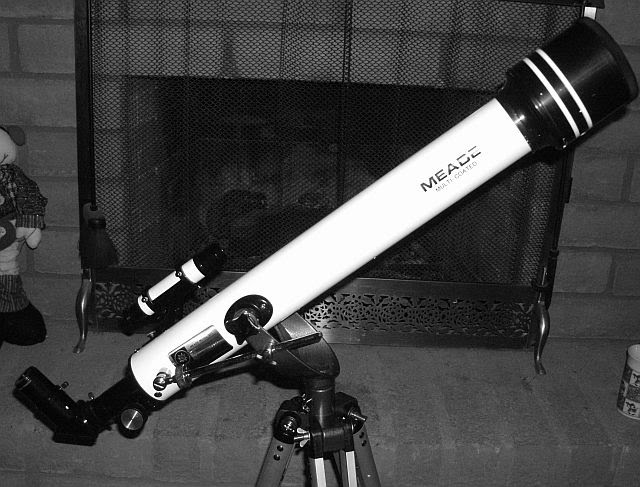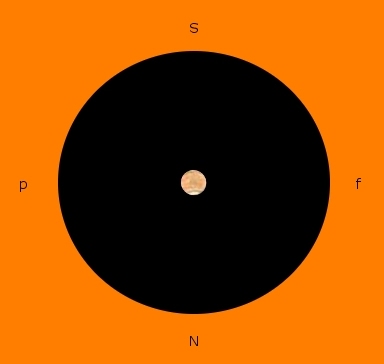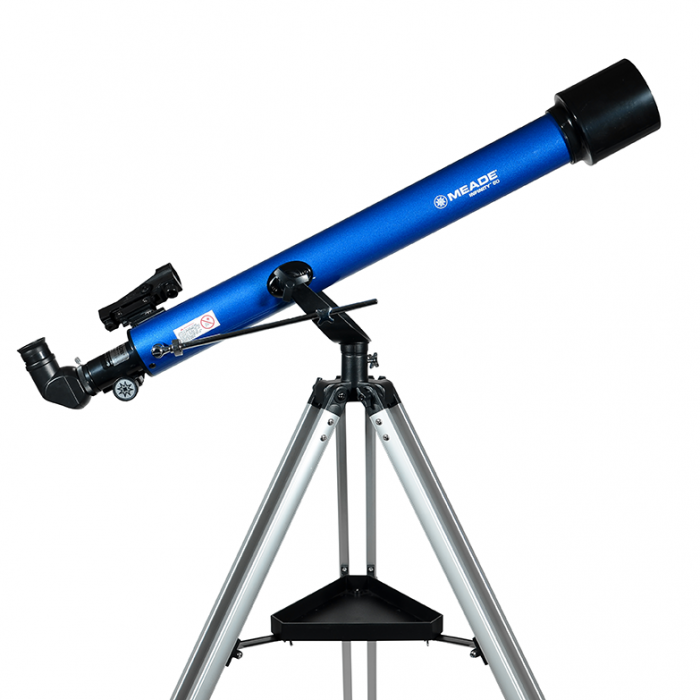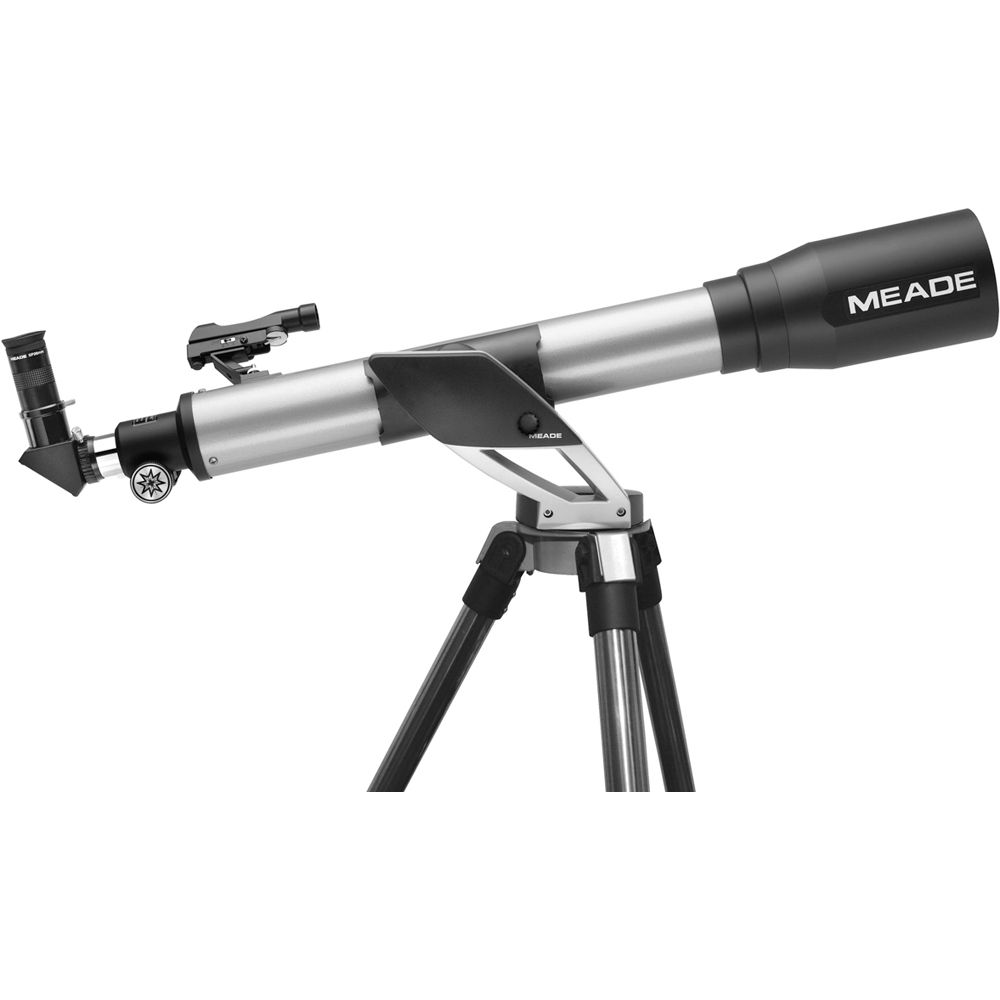
If you read a lot, in just about any magazine, book or blog you hear about the worthlessness of the venerable 60 mm “Dimestore” telescope. Common knowledge is that they are worthless junk only suited for paperweights! Especially if you read forum or FaceBook posts in the astronomy sections. Are these telescopes really that bad, especially since it was, for many of us, our first telescope?
In 2009, just for fun, I ordered a Meade 60mm refractor on E-Bay. It was a 21 dollar purchase and that is with shipping! The mount was wobbly and the eyepieces were outdated designs of the .965 size. Huygens and Ramsdens all! It was the shorter F/11 configuration which showed some chromatic aberration or false color around brighter objects. By all common wisdom this telescope should be a totally worthless piece of junk!
However, it turned out to be a pretty good telescope! The actual quality of the objective lens was quite good. Star testing allowed evenly spaced star diffraction rings inside and outside focus. Even the poor quality eyepieces were quite usable. The main problem was the wobbly mount. These mounts tend to be light and totally unsatisfactory for anything but low power viewing and even then only with some tweaking. Still, with practice, you can use it as it is even at high powers. Tighten up all the screws and bolts of the mount then put a heavy weight on the spreader. This trick can help to to steady even light mounts by using a little Newtonian physics.

The image below is a color sketch of Mars made at the 2009 opposition with the Meade 60mm in stock form when Mars was 18″ across. I used the 4mm Huygen which gave it 165 power view. It was difficult to keep it centered but with a little practice was able to track it for some time while I sketched. If you can see this level of detail on Mars with a poor eyepiece and mount think how much better this could be if you had a better quality eyepiece and mount.

After using it, as it was, out of the box for awhile, I made some improvements on it. A 1.25″ focuser from Telescope Warehouse on Ebay was added along with some modern, higher quality eyepieces. The mount was replaced by a simple Alt/Az (Meade Polaris) mount that is way smoother than the stock mount. A dielectric coated diagonal was used with Plossl eyepieces as well as 2 TMB planetary eyepieces and a couple high quality, low cost, Plossls. The scope was never of Tele-Vue quality but it was excellent, especially for the price. Total cost of scope and updating, 45 dollars, not including eyepieces and diagonal. Then I gave it away to a budding young astronomer! Overall with a little fix up, you can have a solid scope for a grab and go experience. In fact I still use another 60mm scope that I upgraded. It is the scope I grab when I just want to set something up quickly and look at a few brighter objects.
Recently (2019) for 15 dollars I purchased an old F/12 60 mm refractor. It is on a light equatorial mount. It is a generic English brand that was imported from Asia. There is little information on this scope but it works quite well and has very little chromatic aberration. To complement this purchase I also bought a Bresser Alt/Az mount and use it for a grab and go platform. The Bresser mount has already seen my Short Tube 80 mm, Meade 70 mm, Celestron 80 F/11 and my Meade 90 mm F/8.8 and handled all of them very well.

One of the tricks I developed to test these scopes besides the normal star tests is using a Star Analyzer grating. You find a star and look at it’s spectral colors. It is quite easy to see how the normal telescope focuses in green and red, but the blue and red ends are distorted and out of focus. If you set up these scopes side by side and test them with the grating mounted on the same eyepiece you find that each scope has a different level of color correction. The 60 mm F/12 has excellent correction but still sees some small distortion in violet. Even with that flaw it has amazing color correction for a scope I bought for 15 dollars!
The Celestron 80 mm that I have, is a clone of the most excellent 1960’s Vixen scope. These are some of the better achromats of this size you can get. Though the optics are excellent on my Celestron 80 the color correction is just so-so. Still it is a fun telescope to use and gives good images.
The biggest surprise was the Meade 90 mm F/8.8 refractor. The color correction on this scope was excellent. Even looking at the moon you are hard pressed to see the false color. It is there but you really have to look for it to see it. When you use the grating you find that the distortion is primarily in the deep violet color range, near ultraviolet. This telescope seems to have the characteristics of a scope with ED (extra Dispersion) glass. In Neil English’s book “Choosing and Using a Refractor Telescope” he mentions that every once in awhile one of the cheaply produced scopes gets glass that has ED qualities and some folks get lucky.

It’s also unfair to lump all small telescopes into the “junk” category, just because they are low cost. Many of todays low cost telescopes have beefier mountings, 1 1/4′ eyepieces and a red dot finder. Even though the bottom level Meade 60 mm telescope (59 dollars as this is written) has an old tripod design that could be a lot better it still looks way more stable than what I had with mine 50 years ago! Eyepiece and focuser of 1.25″ and red dot finder cut hours off the learning curve compared to my first 50 mm spotting scope on a table top tripod.

I recently purchased a used copy of Neil Bone’s “Deep Sky Observers Guide.” In this most excellent book you find sketchs done with a Short tube 80 mm telescope. It turns out these are outstanding scopes to use for casual observing. Neil bone was one of the foremost experts in achromatic refractors until he passed away from cancer in 2009. That fact that such an expert on refractors chose the lowly 80 mm F/5 to use for sketchs says a lot about it’s usability and quality. Even in today’s high inflation era the Orion 80 mm refractor can still be found used for around 100 dollars.
To sum up this page, its often more about the observer than the telescope! If you have perseverance and a desire to see the universe with your own eyes then just about any scope will show you something. Leslie Peltier spent 190 nights his first year of owning a telescope looking at the night sky with a 2″ collapsible spotting scope! Pretty sure there are lots of low end telescope that can provide at least as good a view!
